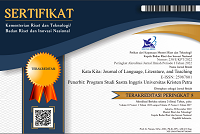The Journey of Becoming a Hero in the Avatar: The Last Airbender Animated Series
DOI:
https://doi.org/10.9744/katakita.9.3.444-451Keywords:
Strategi pemasaran, strategi STP, bauran pemasaran, analisis SWOT, strategi generik PorterAbstract
The popularity of Avatar: The Last Airbender intrigues me to analyze Aang’s journey, as the main character, in becoming a hero. I aim to analyze the stressors that cause Aang’s psychological distress, his coping mechanisms, and how he develops into a hero. To find out about the three aforementioned points, I use theories on psychological distress and coping mechanisms. My analysis demonstrates that Aang’s psychological distress is caused by three stressors: his fear of accepting his new identity and responsibility, his shame, and his fear of the war and failure. To deal with those stressors, Aang adopts two coping mechanisms: emotion-focused (avoidance, seeking social support for emotional purposes, and acceptance), and problem-focused (seeking social support for instrumental purposes, planning, and problem-solving). By the end of the series, Aang has become a hero by developing into a selfless and benevolent humanitarian who used his intelligence and integrity to win the war.
Keywords: psychological distress, stressors, coping mechanism, hero
References
Ardelt, M. (2008). Self-development through selflessness: the paradoxical process of growing wiser. In H. A. Wayment & J. J. Bauer (Eds.), Transcending Self-Interest: Psychological Explorations of The Quiet Ego (pp. 221–233). chapter, American Psychological Association.
Arvidsdotter, T., Marklund, B., Kylén, S., Taft, C., & Ekman, I. (2015). Understanding persons with psychological distress in primary health care. Scandinavian Journal of Caring Sciences, 30(4), 687–694. https://doi.org/10.1111/scs.12289
Baqutayan, S. M. (2015). Stress and coping mechanisms: a historical overview. Mediterranean Journal of Social Sciences. doi:10.5901/mjss.2015.v6n2s1p479
Biggs, A., Brough, P., & Drummond, S. (2017). Lazarus and Folkman’s psychological stress and coping theory. In C. L. Cooper & J. C. Quick (Eds.), The Handbook of Stress and Health: A Guide to Research and Practice (pp. 351–364). chapter, John Wiley & Sons, Inc.
Burnette, J. L., Knouse, L. E., Vavra, D. T., O’Boyle, E., & Brooks, M. A. (2020). Growth mindsets and psychological distress: a meta-analysis. Clinical Psychology Review, 77. https://doi.org/10.1016/j.cpr.2020.101816
Campbell, J. (1993). The hero with a thousand faces. Fontana Press.
DiMartino, M. D. & Konietzko, B. (Executive Producers). (2005-2008). Avatar: The Last Airbender [TV Series]. Nickelodeon Animation Studio.
Drapeau, A., Marchand, A., & Beaulieu-Prevost, D. (2012). Epidemiology of psychological distress. Mental Illnesses - Understanding, Prediction and Control. https://doi.org/10.5772/30872
Llabre, M. M., Hadi, F., La Greca, A. M., & Lai, B. S. (2013). Psychological distress in young adults exposed to war-related trauma in childhood. Journal of Clinical Child & Adolescent Psychology, 44(1), 169–180. https://doi.org/10.1080/15374416.2013.828295
Mirowsky, J., & Ross, C. E. (2003). Social causes of psychological distress. Aldine de Gruyter.
Robitschek, C. (1998). Personal growth initiative: the construct and its measure. Measurement and Evaluation in Counseling and Development, 30(4), 183–198. https://doi.org/10.1080/07481756.1998.12068941
Wells, P. (1998). Understanding animation. Routledge.
Wong, Y., & Tsai, J. (2008). Cultural models of shame and guilt. In J. L. Tracy, R. W. Robins, & J. P. Tangney (Eds.), The Self-Conscious Emotions: Theory and Research (pp. 209–223). chapter, Guilford.
Downloads
Published
Issue
Section
License
Authors who publish with this journal agree to the following terms:- Authors retain copyright and grant the journal right of first publication with the work simultaneously licensed under a Creative Commons Attribution License that allows others to share the work with an acknowledgement of the work's authorship and initial publication in this journal.
- Authors are able to enter into separate, additional contractual arrangements for the non-exclusive distribution of the journal's published version of the work (e.g., post it to an institutional repository or publish it in a book), with an acknowledgement of its initial publication in this journal.
- Authors are permitted and encouraged to post their work online (e.g., in institutional repositories or on their website) prior to and during the submission process, as it can lead to productive exchanges, as well as earlier and greater citation of published work (See The Effect of Open Access).














